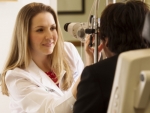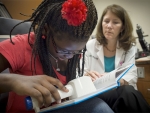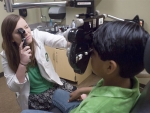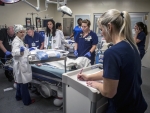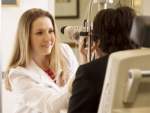Displaying items by tag: department of ophthalmology and visual sciences
The Press Ganey Pinnacle of Excellence Award is a highly regarded symbol of achievement in the health care industry.
Tagged under
Jessica Martindale’s perfect vision was quickly tested after her infant son inadvertently scratched her cornea. Thankfully, physicians at UAB Callahan Eye Hospital were there to help.
Tagged under
Kline is the first ophthalmologist from the state of Alabama to be recognized with the Life Achievement Honor Award.
New research shows that calcified nodules in the eye increase the risk for progression to advanced AMD.
A new grant allows researchers to further identify family-based interventions needed for teen driver safety.
Tagged under
UAB researcher Christine Curcio, Ph.D., recently provided an editorial on the importance of a new online portal for eye banks.
Tagged under
Children and teens with low vision can enjoy a special event at McWane Center sponsored by Songs for Sight.
Tagged under
Tagged under
Tagged under
It is easy to remember steps to prevent the body from getting cold, but what can be done to protect the eyes when cold weather hits?
Tagged under
The ESFA was founded in 1997 after the sale of the Callahan Eye Hospital to UAB, and has a mission of awarding grants to nonprofits conducting vision research, education and patient care.
Tagged under
Glaucoma affects more than 3 million people in the United States and is the leading cause of blindness in African-Americans.
Tagged under
Reintegration into school has been a noticeably neglected area of focus in concussion research, particularly in comparison to research on return-to-play. When and how a student should be fully integrated into the classroom are just two questions UAB and Children’s of Alabama researchers are looking to answer.
Tagged under
Comprehensive eye exams can detect a variety of eye conditions that, left untreated in a child, could result in partial or complete loss of vision later in life.
The ProAssurance Endowed Chair for Physician Wellness at UAB will help address health issues unique to physicians as they deal with the stress and pressures associated with providing care in today’s evolving health care environment.
Tagged under
- school of medicine
- school of nursing
- uab medicine
- department of surgery
- department of radiology
- department of anesthesiology and perioperative medicine
- department of dermatology
- department of emergency medicine
- department of family and community medicine
- department of medicine
- department of neurology
- department of neurosurgery
- department of obstetrics and gynecology
- department of ophthalmology and visual sciences
- department of otolaryngology
- department of pediatrics
- department of pharmacology and toxicology
- department of physical medicine and rehabilitation
- department of radiation oncology
- department of psychiatry and behavioral neurobiology
- department of urology
- release
A screening program conducted by University of Alabama at Birmingham Callahan Eye Hospital ophthalmologists is helping cut negative outcomes from ROP in infants by half.
Tagged under
Tagged under
 A UAB optometrist and ophthalmologist provide advice on how to protect your eyes while viewing the solar eclipse.
A UAB optometrist and ophthalmologist provide advice on how to protect your eyes while viewing the solar eclipse.
Tagged under
Tagged under
Gamlin has been appointed chair of the Mechanisms of Sensory, Perceptual and Cognitive Processes Study Section at the Center for Scientific Review for the NIH.
